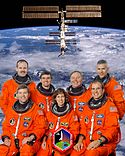STS-110
 | |
| Dane misji | |
| Indeks COSPAR | 2002-018A |
|---|---|
| Zaangażowani | |
| Oznaczenie kodowe | STS-110 |
| Pojazd | |
| Wahadłowiec | |
| Załoga | |
 Z przodu od lewej: Stephen N. Frick, Ellen Ochoa, Michael J. Bloomfield; z tyłu od lewej: Steven L. Smith, Rex J. Walheim, Jerry L. Ross i Lee M.E. Morin | |
| Dowódca | |
| Start | |
| Miejsce startu | |
| Początek misji | |
| Orbita okołoziemska | |
| Apogeum | 402 km |
| Perygeum | 309 km |
| Okres orbitalny | 91,7 min |
| Inklinacja orbity | 51,6° |
| Lądowanie | |
| Miejsce lądowania | KSC, pas startowy 33 |
| Lądowanie | 19 kwietnia 2002 16:26:57 UTC[1] |
| Czas trwania misji | |
| Przebyta odległość | 7,24 mln km[2] |
| Liczba okrążeń Ziemi | 171[2] |
| Program lotów wahadłowców | |
STS-110 (ang. Space Transportation System) – misja NASA do Międzynarodowej Stacji Kosmicznej, z użyciem wahadłowca Atlantis. Był to dwudziesty piąty lot promu kosmicznego Atlantis i sto dziewiąty programu lotów wahadłowców[3].
Załoga
- Michael Bloomfield (3)*, dowódca (CDR)
- Stephen N. Frick (1), pilot (PLT)
- Jerry Ross (7), specjalista misji (MS4)
- Steven Smith (4), specjalista misji (MS5)
- Ellen Ochoa (4), specjalista misji (MS2)
- Lee Morin (1), specjalista misji (MS3)
- Rex J. Walheim (1), specjalista misji (MS1)
- *(liczba w nawiasie oznacza liczbę lotów odbytych przez każdego z astronautów)
Parametry misji
- Masa:
- startowa orbitera: 257 079 kg
- lądującego orbitera: 200 657 kg
- ładunku: 13 132 kg
- Perygeum: 309 km[5]
- Apogeum: 402 km[5]
- Inklinacja: 51,6°[5]
- Okres orbitalny: 91,7 min[5]
Cel misji
Trzynasty lot wahadłowca na stację kosmiczną ISS – dostarczenie segmentu SO kratownicy ITS[3].
Dokowanie do stacji ISS
- Połączenie z ISS: 10 kwietnia 2002, 16:05:00 UTC[1]
- Odłączenie od ISS: 17 kwietnia 2002, 18:31:00 UTC[1]
- Łączny czas dokowania: 7 dni, 2 h, 26 min, 00 s
Zobacz też
Przypisy
- ↑ a b c d e Spaceflight mission report: STS-110 (ang.). Spacefacts. [dostęp 2017-07-27].
- ↑ a b c KSC: Podsumowanie misji STS-110 (ang.). [dostęp 2010-08-31].
- ↑ a b c Tomáš Přibyl: Dzień, w którym nie wróciła COLUMBIA. Bielsko-Biała: Wydawnictwo >DEBIT<, 2003, s. 177. ISBN 83-7167-224-1.
- ↑ Robert Godwin: Space Shuttle. Warszawa: Prószyński Media Sp. z o.o., 2011, s. 86. ISBN 978-83-7648-973-5.
- ↑ a b c d Mark Wade: STS-110 (ang.). W: Encyclopedia Astronautica [on-line]. [dostęp 2017-07-27].
Linki zewnętrzne
- Mark Wade: STS-110 (ang.). W: Encyclopedia Astronautica [on-line]. [dostęp 2017-07-27].
- Spaceflight mission report: STS-110 (ang.). Spacefacts. [dostęp 2017-07-27].
Media użyte na tej stronie
The flag of Navassa Island is simply the United States flag. It does not have a "local" flag or "unofficial" flag; it is an uninhabited island. The version with a profile view was based on Flags of the World and as a fictional design has no status warranting a place on any Wiki. It was made up by a random person with no connection to the island, it has never flown on the island, and it has never received any sort of recognition or validation by any authority. The person quoted on that page has no authority to bestow a flag, "unofficial" or otherwise, on the island.
Emblem of Nasa's STS-110 mission.
- The STS-110 mission begins the third and final phase of construction for the International Space Station (ISS) by delivering and installing the SØ truss segment that will be carried into orbit in the payload bay of the Space Shuttle Atlantis. The Station’s robotic arm will remove the SØ segment from the Shuttle’s payload bay and place it on top of the United States Laboratory. During several space walks, SØ will be mechanically attached to ISS, and then multiple cables will be connected allowing electrical power and communications to flow between SØ and ISS. The STS-110 crew patch is patterned after the cross section of the SØ truss, and encases the launch of the Shuttle Atlantis and a silhouette of the ISS as it will look following mission completion. The successfully installed SØ segment is highlighted in gold. The SØ truss will serve as the cornerstone for the remaining ISS truss segments which together will span a distance greater than the length of a football field. This truss holds the Station’s massive solar arrays, providing electrical power for the modules of all the International Partners, and enables ISS to reach its full potential as a world-class research facility.
These seven astronauts are in training for the STS-110 mission, scheduled to visit the International Space Station early next year. In front, from the left, are astronauts Stephen N. Frick, pilot; Ellen Ochoa, flight engineer; and Michael J. Bloomfield, mission commander; In the back, from left, are astronauts Steven L. Smith, Rex J. Walheim, Jerry L. Ross and Lee M.E. Morin, all mission specialists.




